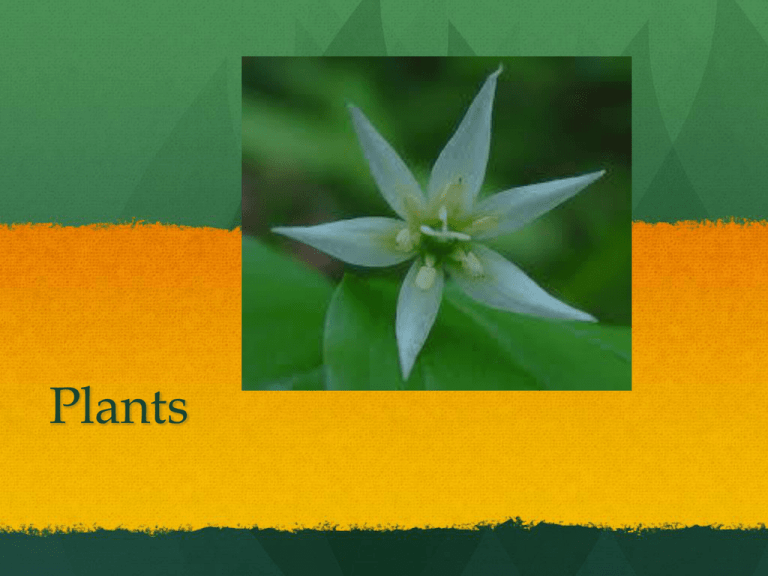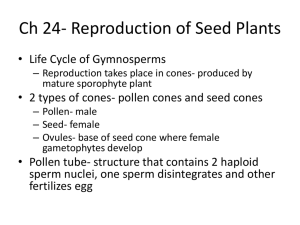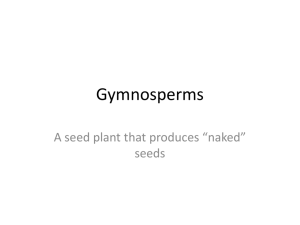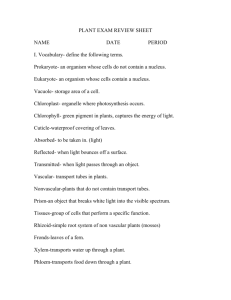Plant PPT
advertisement

Plants Teaching Point #1 Almost all plants are autotrophic, eukaryotic and have cell walls. Teaching Point #2 Plants are grouped into 2 groups: nonvascular plants, which lack a well–developed system of tubes for transporting materials, and vascular plants, which have a system to transport materials. Teaching Point #3 The 3 main major groups of nonvascular plants are mosses, liverworts and hornworts, which all are low-growing plants in moist areas where they can directly absorb water and nutrients. Teaching Point #4 Ferns, club mosses and horsetails have vascular tissue but do not produce seeds; instead they reproduce by releasing spores. Teaching Point #5 Seed plants are vascular, use pollen and seeds to reproduce, and have stems and leaves to provide support and nutrients. Teaching Point #6 Gymnosperms produce naked seeds and angiosperms produce flowers and fruits. Teaching Point #7 In gymnosperms pollen falls from a male cone onto a female cone, and in angiosperms pollen from the anther falls on the flower’s stigma. Characteristics of Plants Multi-cellular Have cell walls Plants Vary in size Make their own energy (autotrophs) Adaptations for living on land Process Water plant (algae) Land Plant Adaptation Obtaining water Receive water right from their surroundings… always! Cuticle: Waxy layer that covers leaf: keeps water in Obtaining /transporting nutrients Nutrients flow TO them in the water…so easy! No need to transport because they are SO small. Evolved to have transport tissue (vascular tissue) Support Water holds them up…floating along. Rigid cell walls and roots Reproduction Sperm can swim to the egg Adaptations for DRY environments that allow sperm to reach egg Complex Life Cycle Sporophyte stage: A sporophyte produces SPORES, which are tiny cells that can grow into new organisms. Gametophyte stage: The plant produces sperm cells and egg cells. What does it mean to be vascular or nonvascular? Nonvascular plants: NO VASCULAR TISSUE! (low-growing, no roots for absorbing water) Vascular plants: HAVE VASCULAR TISSUE! (Suited to life on dry land, transport materials throughout plant, so can grow tall) Information check 1. Name 2 ways plant cells are different from other eukaryotic cells. 2. What adaptations do land plants have the water plants don’t? 3. Does algae need cuticles? Why or why not? 4. How do vascular plants differ from nonvascular plants? 5. What are the 2 major stages of a plant’s life? Plants WITHOUT Seeds Mosses, liverworts, hornworts Ferns, club mosses, horsetails Low growing plants Can grow tall because they can transport materials Moist areas (to directly absorb water) Also need moist areas for spores Need watery surrounding for sperm to swim to egg Reproduce by releasing spores Characteristics of SEED plants Vascular tissue: Phloem and Xylem Pollen and seeds Stems Roots Leaves Purpose of each… Phloem: Moves the food throughout the plant so nutrients reach EVERY cell! Xylem: Moves the water and minerals from soil to the rest of plant. Pollen: Sperm cells (that will eventually fertilize the egg cells) Seed: The zygote! Seed contains the young plant and PROTECTS it. Roots: Anchor the plant and absorb water and nutrients Stem: Carries substances from roots up to plant. Also, holds the plant and leaves up so they can be exposed to sun Leaves: Capture sun’s energy to make food (photosynthesis!) Information check 1. Nonvascular seedless plants are all low-growing and live in moist areas. How are these 2 characteristics related? 2. What do you think is the MOST important adaptation of seed plants? Why? Angiosperms • All have flowers(The reproductive structure of angiosperms) • All have seeds protected by a FRUIT SEED PLANTS • All have “naked seeds” = NOT protected! • Many have needlelike leaves Gymnosperms Reproduction in gymnosperms Example: Pine Tree Wind disperses seed. Seed grows into a tree Ovule develops into a seed Tree produces male and female cones Fertilization occurs: ovule seals in pollen. Male cone produces pollen grains, which turn into sperm cells Wind scatters pollen seeds, end up on female cone (ovule) Reproduction in angiosperms (Example: Apple Tree) The ovary turns into the fruit, which helps dispersal. YUM. Ovule of plant develops into a seed! (fertilized egg is the embryo) Apple tree produces flowers Fertilization: pollen (sperm) fertilizes egg cell Cells in the anther produce pollen grains Pollen grains trapped on the stigma Flower structure Where pollen is deposited Attract pollinators Location of pollen Develops into a SEED Ovary: Becomes the FRUIT: dispersal of seed Information Check 1. Why are cones important for gymnosperms? 2. Compare and contrast reproduction in angiosperms and gymnosperms. (How are they similar? Different?) 3. What characteristics do all angiosperms share? 4. Is the following picture a gymnosperm or angiosperm? Check for Understanding What is the difference between a vascular and nonvascular plant? Give as many differences as you can. Name adaptations that distinguish flowering plants from mosses. Explain the role of stomata in leaves. What role does a fruit play in an angiosperm’s life cycle? Give as many details as possible. How does the sporophyte generation of a plant differ from the gametophyte generation of a plant? What are the main functions of a plant’s roots, stems and leaves?





